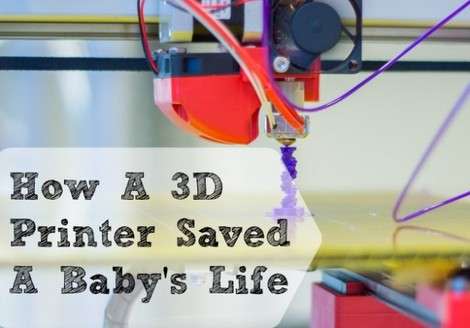How a 3D Printer Saved a Baby’s Life

When my daughter was only about eight months old, she woke us up with the most horrible and terrible cough I'd ever heard in my life. We thought she was dying. In a complete panic, we drove like lunatics to the local emergency room only to be patted on the head and told she had croup. The nurses put her in front of a humidifier, and in about 20 minutes she was fine. But I still remember that horrible feeling of panic.
I thought of that day when I heard a story on NPR this morning talking about Garrett, a baby born with tracheobronchomalacia. For 16 months Garrett has lived at the hospital. From the article:
"He could go from being totally fine to turning blue sometimes -- not even kidding -- in 30 seconds," says Garrett's mother, Natalie Peterson, 25, of Layton, Utah. "It was so fast. It was really scary."
As a mother, I cannot imagine.
Related: 10 baby gadgets you'll actually use
We've heard plenty of amusing (and sometimes scary) stories about 3D printers being used to make everything from jewelry to guns to fashions appearing on the runways this year. However, I believe the really exciting stories in the 3D printing world are medical. Medical experts are creating amazing things with 3D printers -- ears, noses, skull portions, and amazingly, skin. There are plenty of dental applications as well; apparently, it soon might be possible to print crowns while you wait.
But my favorite story is Garrett's. While he was hospitalized in Utah, his parents and medical team decided something more needed to be done:
"The Petersons contacted Dr. Glenn Green at the University of Michigan, who specializes in conditions like Garrett's. He teamed up with Scott Hollister, a biomedical engineer who runs the university's 3-D Printing Lab, to create a remarkable solution to Garrett's problem -- a device that will hold open Garrett's windpipe until it's strong enough to work on its own."
It took some effort -- transporting a baby this sick across the country is an expensive challenge, and the FDA had to grant an emergency waiver to allow a non-approved device to be used -- but Garrett got his surgery, and he's breathing much more easily.
Green says this is the most exciting thing he has seen since medical school. "We're talking about taking something like dust and converting it into body parts," he says. "And we're able to do things that were never possible before."
-Photo Credit: Cecily Kellogg
-By: Cecily Kellogg
For 10 baby products that are worth the splurge, visit Babble!
MORE ON BABBLE
5 surprising milestones every new mom must go through
25 things not to do with your baby
The 9 toughest things about being a parent

